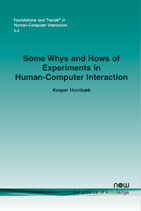Some Whys and Hows of Experiments in Human–Computer Interaction
By Kasper Hornbæk, Department of Computer Science, University of Copenhagen, Denmark, kash@diku.dk
Abstract
Experiments help to understand human–computer interaction and to characterize the value of user interfaces. Yet, few intermediate guidelines exist on how to design, run, and report experiments. The present monograph presents such guidelines. We briefly argue why experiments are invaluable for advancing human–computer interaction beyond technical innovation.We then identify heuristics of doing good experiments, including how to build on existing work in devising hypotheses and selecting measures; how to craft challenging comparisons, rather than biased win–lose setups; how to design experiments so as to rule out alternative explanations; how to provide evidence for conclusions; and how to narrate findings. These heuristics are exemplified by excellent experiments in human–computer interaction.
Some Whys and Hows of Experiments in Human–Computer Interaction
Experiments in Human-Computer Interaction (HCI) work by deliberately introducing interventions that might affect the interaction between humans and computers, and describing the effects of these interventions. They form an important part of HCI methodology, and help to understand human-computer interaction and characterize the value of user interfaces. Yet, few intermediate guidelines exist on how to design, run, and report experiments.
Some Whys and Hows of Experiments in Human-Computer Interaction presents such guidelines. It briefly argues why experiments are invaluable for advancing human-computer interaction beyond technical innovation, and then goes on to identify heuristics of doing good experiments. These include: how to build on existing work in devising hypotheses and selecting measures; how to craft challenging comparisons, rather than biased win-lose setups; how to design experiments so as to rule out alternative explanations; how to provide evidence for conclusions; and how to narrate findings. The text argues and seeks to exemplify how the quality of experiments in HCI can been improved through the use of these heuristics, which are exemplified by excellent experiments in human-computer interaction.
Some Whys and Hows of Experiments in Human-Computer Interaction is an invaluable reference for all experimenters in HCI.
